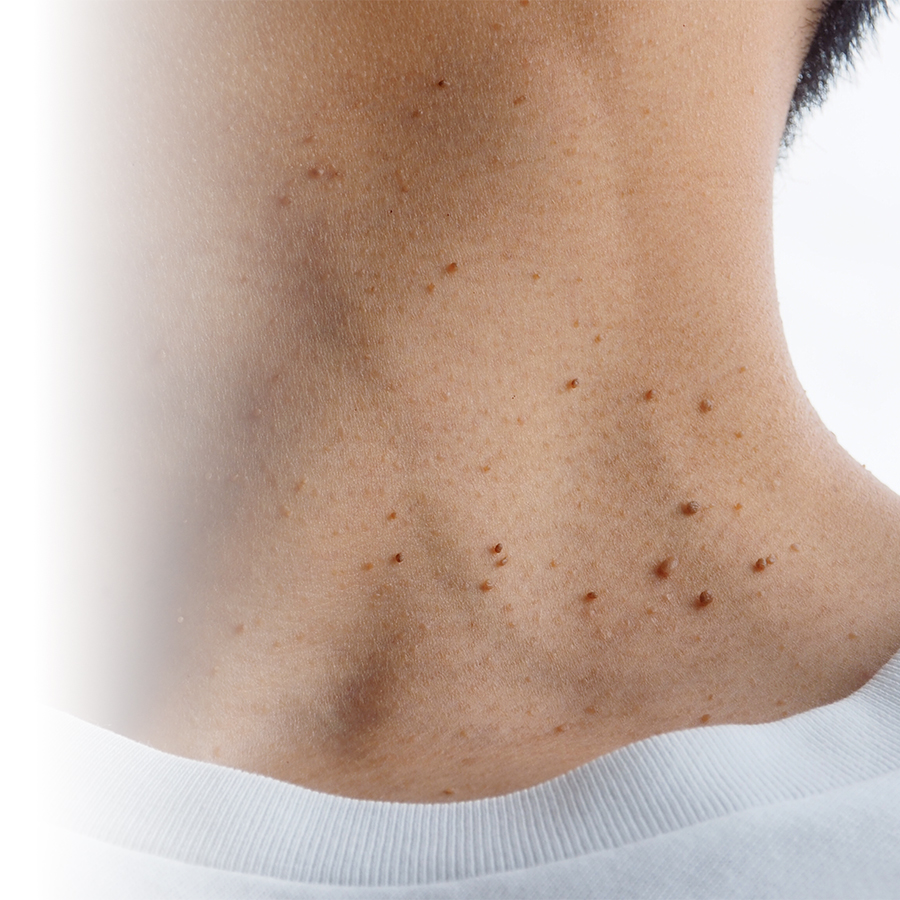Acrochordons are painless and aren’t generally of any health risk, but some people might still want to have them removed for aesthetics or comfort.
What is an acrochordon?
Acrochordons, also known as "molluscum pendulum" or "skin tags," are small, generally harmless growths on the skin that usually appear in areas where the skin folds and rubs against itself, like the neck, armpits, groin or eyelids.
While they can vary in size, they’re usually identified by their smooth, round appearance, soft texture and skin-like colour. Some can be as small as the head of a pin, while others can reach 4 to 5 millimeters in diameter.
Attention: don’t get them confused with skin warts or moles!
- Warts are also small outgrowths of skin, but they’re usually rougher in texture and have a more irregular surface than acrochordons. And, unlike acrochordons, they’re caused by virus.
- Moles are also smooth and round in appearance, but they can appear anywhere on your body and are usually much darker in colour.
Not sure if it’s an acrochordon? Feel free to speak to your pharmacist or other health-care professional to rule out any other type of skin problem.
What causes acrochordons ?
The exact cause of acrochordons is still unknown, and there’s no real way of preventing them. However, they generally appear in greater number as you grow older.
Despite the lack of proof, certain theories have been developed in an attempt to explain the appearance of these skin outgrowths.
These include:
- Skin rubbing or friction;
- Genetic predisposition;
- Hormonal imbalance, ex.: pregnancy;
- Being overweight;
- Diabetes;
- Exposure to sunlight.
How can you get rid of acrochordons?
Several types of treatment and procedure are offered by healthcare professionals.
Cauterisation
This involves burning or destroying the acrochordon tissues using heat emitted from a laser or a heated metal rod called a cautery.
Cryotherapy
Cryotherapy is a treatment that uses liquid nitrogen to create extremely cold temperatures that freeze off acrochordons and other skin lesions by destroying their cells.
Electro-coagulation
For this treatment, a healthcare professional uses an instrument called an electrocautery that uses a high-frequency electric current to generate extremely high heat that burns and destroys the acrochordon tissues.
Surgery
Acrochordons can also be surgically removed, especially when they are large or numerous. Here, a surgeon or dermatologist simply cuts the acrochordon from the skin with a surgical instrument, like a scalpel.
Are there any acrochordon treatments available at the pharmacy?
There are non-prescription, over-the-counter treatments available in pharmacies to help you remove acrochordons at home. They generally feature an applicator with a product similar to liquid nitrogen that’s used to freeze the growth. Once the treatment has been applied, the acrochordon will usually simply fall off after ten days or so.
It's important to consult a pharmacist before you use this type of treatment to ensure it really is an acrochordon and the area is safe for the treatment. Note: these treatments should never be used near mucous membranes, like the nostrils, mouth or genitals, or on the skin around your eyes.
Did you know that some Jean Coutu-affiliated pharmacies offer acrochordon-removal services, and the procedure takes just a few minutes? Check with your local Jean Coutu for details.
Can acrochordons be dangerous if they’re left untreated?
Generally speaking, acrochordons aren’t dangerous if left untreated; they’re usually medically harmless. Deciding to remove them is a question of comfort or aesthetics. However, in rare cases, acrochordons can cause problems if they get irritated or become caught up in clothing or jewelry. Such irritations can lead to pain, inflammation, bleeding or infection.
Furthermore, while acrochordons are generally benign, it’s important to note that any change in their appearance, size, colour or texture may require medical evaluation to rule other types of health problems.
Feel free to speak to your pharmacist if you have any questions or concerns about acrochordons.

